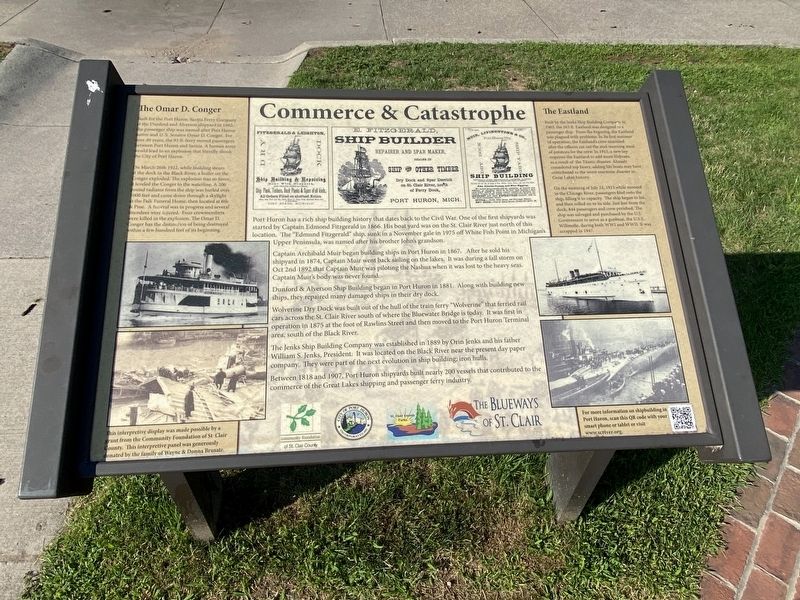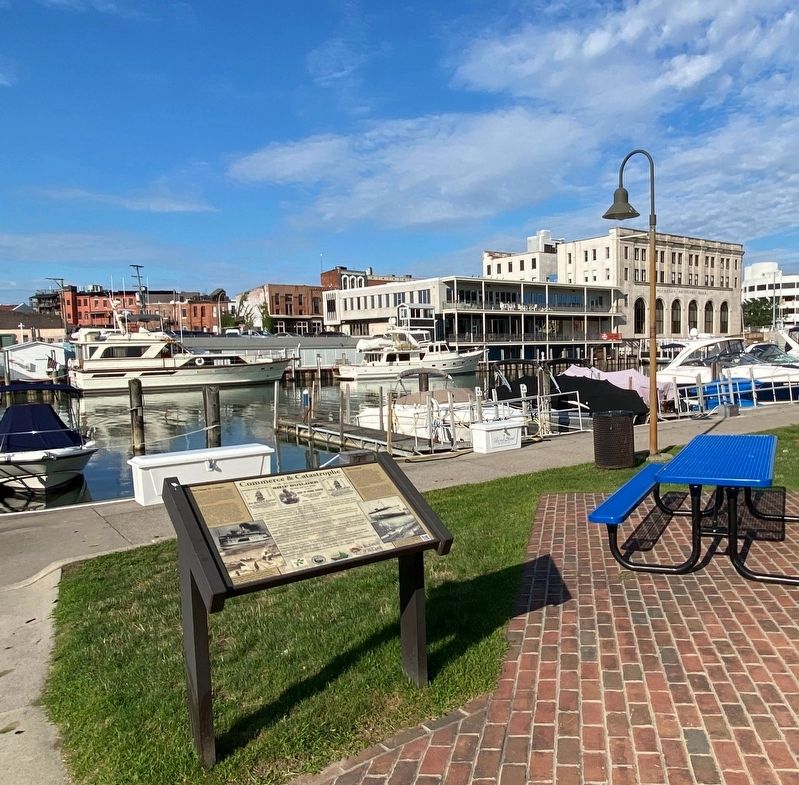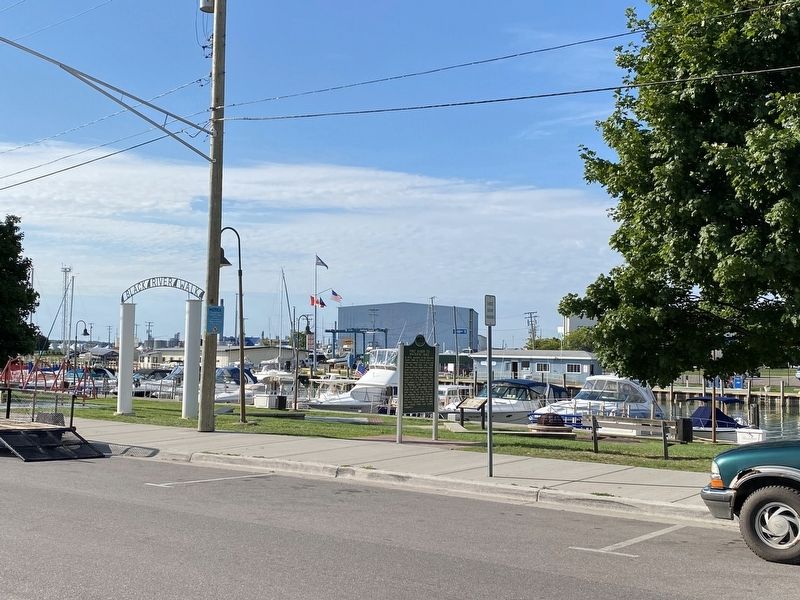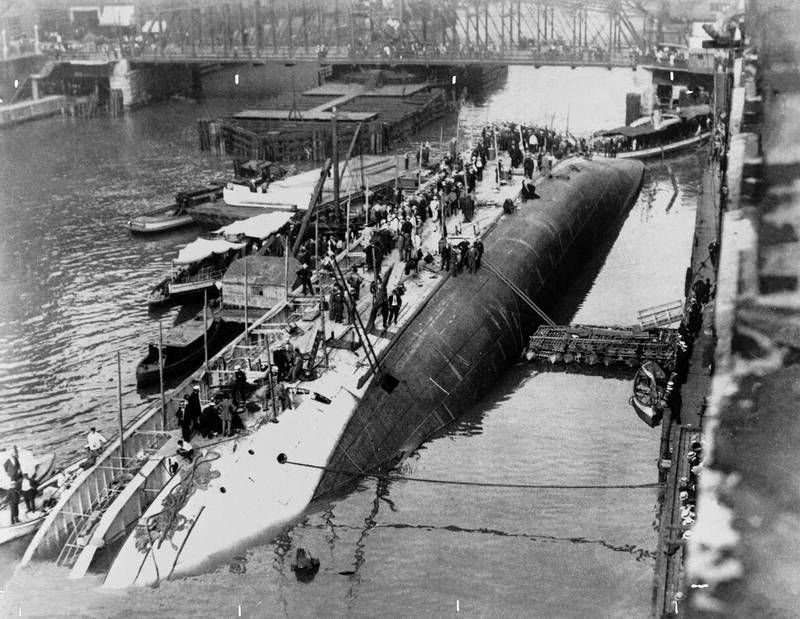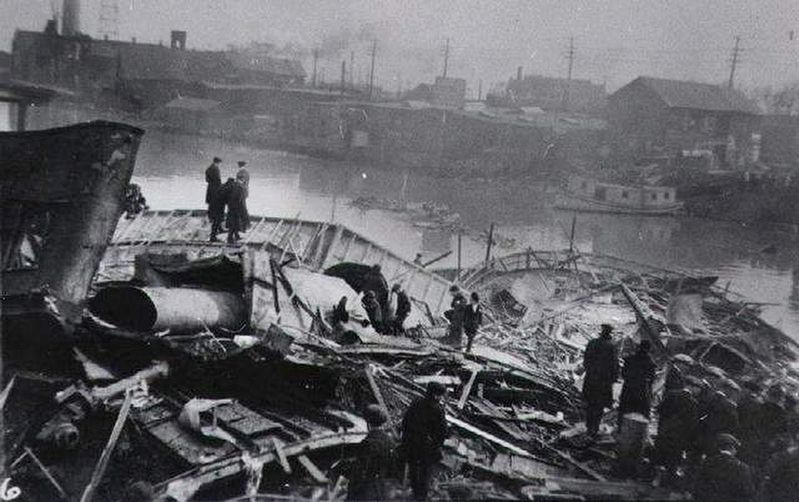Port Huron in St. Clair County, Michigan — The American Midwest (Great Lakes)
Commerce & Catastrophe
The Omar D. Conger
Built for the Port Huron-Sarnia Ferry Company at the Dunford and Alverson shipyard in 1882, the passenger ship was named after Port Huron native and U.S. Senator Omar D. Conger. For over 40 years, the 93 ft. ferry moved passengers between Port Huron and Sarnia. A human error would lead to an explosion that literally shook the City of Port Huron.
On March 26th 1922, while building steam at the dock in the Black River, a boiler on the Conger exploded. The explosion was so fierce, it leveled the Conger to the waterline. A 200 pound radiator was hurled over 1000 feet and came down through a skylight at the Far Funeral Home, then located at 6th & Pine. A funeral was in progress and several attendees were injured. Four crewmembers were killed in the explosion. The Omar D. Conger has the distinction of being destroyed within a few hundred feet of its beginning.
Port Huron has a rich ship building history that dates back to the Civil War. One of the first shipyards was started by Captain Edmond Fitzgerald in 1866. His boat yard was on the St. Clair River just north of this location. The "Edmund Fitzgerald" ship sunk in a November gale in 1975 off White Fish Point in Michigan's Upper Peninsula, was named after his brother John's grandson.
Captain Archibald Muir began building ships in Port Huron in 1867. After be sold his shipyard in 1874, Captain Muir went back sailing on the lakes. It was during a fall storm on Oct 2nd 1892 that Captain Muir was piloting the Nashua when it was lost to the heavy seas. Captain Muir's body was never found.
Dunford & Alverson Ship Building began in Port Huron in 1881. Along with building new ships, they repaired many damaged ships in their dry dock.
Wolverine Dry Dock was built out of the hull of the train ferry "Wolverine" that ferried rail cars across the St. Clair River south of where the Bluewater Bridge is today. It was first in operation in 1875 at the foot of Rawlins Street and then moved to the Port Huron Terminal area, south of the Black River.
The Jenks Ship Building Company was established in 1889 by Orin Jenks and his father William S. Jenks, President. It was located on the Black River near the present day paper company. They were part of the next evolution in ship building; iron hulls.
Between 1818 and 1907, Port Huron shipyards built nearly 200 vessels that contributed to the commerce of the Great Lakes shipping and passenger ferry industry.
The Eastland
Built by the Jenks Ship Building Company in 1903, the 265 ft. Eastland was designed as a passenger ship. From the beginning, the Eastland was plagued with problems. In its first summer of operation, the Eastland's crew mutinied after the officers cut out the mid-morning meal of potatoes for the crew. In 1915, a new law required the Eastland to add more lifeboats, as a result of the Titanic disaster. Already considered top heavy, adding life boats may have contributed to the worst maritime disaster in Great Lakes history.
On the morning of July 25, 1915 while moored in the Chicago River, passengers filed onto the ship, filling it to capacity. The ship began to list, and then rolled on to its side. Just feet from the dock, 844 passengers and crew perished. The ship was salvaged and purchased by the U.S. Government to served as a gunboat, the U.S.S. Willmette, during both WWI and WWII. It was scrapped in 1947.
Erected by Community Foundation.
Topics and series. This historical marker is listed in these topic lists: Disasters • Industry & Commerce • Waterways & Vessels. In addition, it is included in the Lost at Sea series list. A significant historical date for this entry is March 26, 1922.
Location. 42° 58.52′ N, 82° 25.355′ W. Marker is in Port Huron, Michigan, in St. Clair County. Marker is at the intersection of Quay Street and Fort Street, on the right when traveling east on Quay Street. Touch for map. Marker is at or near this postal address: 301 Quay Street, Port Huron MI 48060, United States of America. Touch for directions.
Other nearby markers. At least
8 other markers are within walking distance of this marker. Port Huron to Mackinac Race / Yacht Clubs and World War II (a few steps from this marker); Admiralty Anchor (within shouting distance of this marker); Intersection of Military Road and Indian Reservation (about 500 feet away, measured in a direct line); Customhouse (approx. 0.2 miles away); Civil War Memorial (approx. 0.2 miles away); Harrington Hotel / Truman Honeymoon (approx. 0.2 miles away); Hammond American Legion Post 8 Memorial (approx. ¼ mile away); Port Huron Public Library (approx. ¼ mile away). Touch for a list and map of all markers in Port Huron.
Also see . . .
1. The Omar D. Conger river ferry went out with a blast. Sarnia Journal website entry:
Excerpt:
The Conger’s boiler fires were lit, but water levels were dangerously low. When one of the crew opened a valve and allowed cold water to rush into the overheated boiler the result was sudden, tragic and spectacular.(Submitted on March 5, 2023, by J.T. Lambrou of New Boston, Michigan.)
2. Eastland Disaster. Britannica website entry:
Excerpt:
The event, which claimed at least 844 lives, ranks as one of the worst maritime disasters in American history. It also is among the city’s deadliest catastrophes: hundreds more lives were lost in the Eastland disaster than in the Chicago fire of 1871.(Submitted on March 5, 2023, by J.T. Lambrou of New Boston, Michigan.)
Credits. This page was last revised on March 8, 2023. It was originally submitted on March 5, 2023, by J.T. Lambrou of New Boston, Michigan. This page has been viewed 200 times since then and 89 times this year. Photos: 1, 2, 3, 4, 5. submitted on March 5, 2023, by J.T. Lambrou of New Boston, Michigan. • J. Makali Bruton was the editor who published this page.
